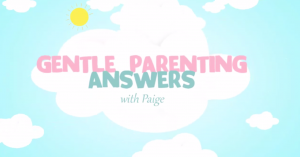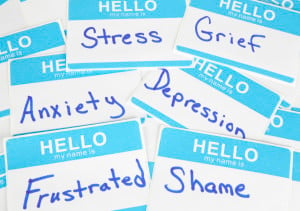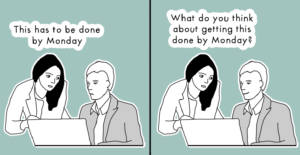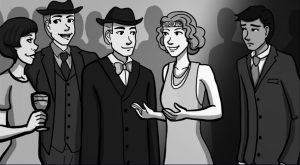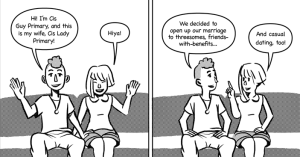
A hand writes the word “Abortion” on a chalkboard.
Due to much political and cultural misinformation around later-term abortions, there remains a lot of fear, stigma, and confusion around what they actually are and who gets them.
Many people who identify as pro-choice – politicians in particular – are all too ready to distance themselves from late-term abortions, some altogether disagreeing on their legality.
In a recent Gallup poll, only 14% of respondents said they believe that third trimester abortions should be legal, with only 27% saying that second trimester abortions should be legal.
And yet 61% believe that first trimester abortions should be legal.
When the Roe v. Wade decision legalized abortion in the U.S. in 1973, it held that states may still place restrictions on gestational age—which is to say, the age of a pregnancy.
And restrict they have – there are currently 41 states with gestational limits.
State and federal laws regulating abortions seem constantly in the public and political eye. A current example is the “Pain Capable Unborn Child Protection Act,” a Congressional bill that would ban abortions after 20 weeks on a national level.
“Partial birth abortions,” a term referring to a particular procedure that was being used only rarely for abortions over 16 weeks, was banned in 2003 by the Bush administration.
The term, created by the National Right to Life Committee, is not a medical term, and has been used primarily in political discourse, effectively perpetuating the misconceptions and stigma around late term abortions and increasing the likelihood that legislators could pass similar restrictions in their own states.
The chipping away of abortion access is a real threat, and we see it at it’s strongest in the regulation of late-term abortions, where anti-choice legislators have a much easier time convincing the public to place limits – much easier than to ban abortion outright.
The way late term abortions are spoken about in political discourse and the media seems often from a place of deep fear and confusion.
But what do we actually know about late term abortions?
What is a late term abortion?
Late term abortions tend to refer to those performed at or after 24 weeks, although increasingly it has been used to refer to earlier procedures – those performed after just 20 weeks.
Despite public misconception, abortions performed after 20 weeks only make up about 1% of total abortions (the vast majority are within the first 12 weeks of pregnancy, also called the first trimester).
Late term abortions are usually much more expensive than earlier terminations. With the prices often going up into the tens of thousands, and the lack of health insurance coverage, the cost of this procedure is a major barrier to access, particularly for low-income women.
Due to state regulations around late term abortions and the resulting cross-state and cross-country traveling that is required to access them, obtaining a late term abortion is made even more difficult financially, physically, and emotionally.
Why do people get late term abortions?
There are all kinds of assumptions made about those who have late term abortions – with myths of laziness, apathy, and cruelty creating the stigma – and this stigma is detrimental to those who need these procedures.
But what are the reasons people have for actually getting late term abortions?
First, I’ll tell you what they’re not.
Late term abortions are not “used as birth control,” despite this illogical cultural myth that they are.
Because really, I’ll just travel to Germantown, Maryland and spend three days and $10,000 there every time I want to take birth control. It’s that easy.
Late term abortions are not easy. First and second trimester abortions might be for those with the support and resources.
But late term abortions unfortunately aren’t. The endless barriers and challenges make them difficult, complex, and expensive procedures, thanks in part to a culture that wishes they did not exist.
So why do people get late term abortions? Not for the reasons you’d expect.
Many late term abortions occur for wanted pregnancies.
Due to either fetal anomalies or risks to the health of the patient, a pregnancy that is otherwise wanted/planned may be terminated.
These pregnancies make up a large portion of those who have the procedure, and these are often extremely difficult experiences.
People typically find out about birth defects around 20 weeks, and those faced with this possibility must make difficult decisions as they consider the quality of life for their family.
These abortions can feel like incredible losses for people, and the stigma that surrounds the procedure, as well as the financial and geographical barriers, make it all the more painful.
Some patients don’t know they’re pregnant.
This can sound like the stuff of reality shows, but it’s actually not uncommon.
For many people, no symptoms of pregnancy are experienced, so it can take a while to learn that they’re pregnant. Sometimes it’s because they were on birth control and don’t get normal periods, sometimes they’re dealing with other physical problems and don’t notice the signs.
For others, there can be an element of denial. If I don’t act on this, it will just go away. Terrified to tell their parents and deal with the pregnancy, many young people who become pregnant fall into this category.
This state of denial can also come from a paralysis of coping mechanisms, which is often experienced by those who have been victims of past trauma.
There are many patients who cannot afford their abortion earlier in the pregnancy, and end up “chasing the price.” Once the procedure goes past 12 weeks, the price often goes up hundreds by the week, and this can leave many struggling to get the money as each week the price goes up even higher.
There are many reasons why people get late term abortions, and the reactions and emotional responses from patients are complex, and often particularly difficult.
And yet the way late term abortions are discussed in the media largely ignore the actual stories of those who need them.
Humanizing those who seek these procedures is crucially important and is an integral part of understanding the procedure and working for greater access.
Who is performing them?
While anti-abortion clinic harassment and violence affects every abortion clinic, clinics and doctors who perform late term abortions are frequent targets, often experiencing the most devastating violence.
For years leading up to the tragic assassination of late-term abortion provider Dr. George Tiller in 2010, anti-choice extremists engaged in constant scare tactics aimed at Dr. Tiller and his clinic in Kansas. His murder only added fuel to the fire of fear experienced by late-term abortion providers, perpetuated by anti-choice activists and a culture that supports them.
The sadness that surrounded Dr. Tiller’s murder was made worse by the fact that the world had lost not only a great man, but also one of the last remaining late-term abortion doctors.
There remain today only 4 doctors left in the U.S. who perform third trimester abortions.
That’s three clinics, meaning that when a person needs a late-term abortion, they have only three places to go in the entire country.
These brave people are Dr. Hern in Colorado, Dr. Carhart in Maryland, and Dr. Boyd and Dr. Robinson in New Mexico.
There is no question: these doctors are heroes.
To get a better understanding of the daily experiences of these doctors and their patients amidst our country’s anti-abortion extremism, watch this truly moving documentary, After Tiller.
The documentary shows how these four doctors continue to perform late-term abortions in the face of constant bullying and intimidation at their homes and clinics and amidst a culture that, at best, does not support them, and at worst, despises them.
Dr. Leroy Carhart, a doctor based just outside of Washington, D.C., has experienced more than his share, and seems to have replaced Dr. Tiller as the main target of anti-choice groups like Operation Rescue, with websites like Kick Out Carhart and images of him posted all over the internet, as well as on the signs of protestors who stand daily outside of his clinic.
And they’ll do anything they can to get him to stop providing abortions – from protesting the middle school where the child of Carhart’s landlord attends class, to handing out fliers to his neighbors labeling him a “murderer.” In 1991, his Nebraska farm was burned down, killing his dog, cat, and 17 horses.
Anti-abortion clinic violence in this country is so insidious and horrific that it truly warrants another article entirely.
But the point I’m hoping to make here is that we all talk about clinic violence and how horrible it is, but we forget that late term abortion providers experience the worst of it, and without our support and defense, it will continue to happen.
Beyond the terror it causes the patients and doctors experiencing it, this violence and intimidation has also served to scare doctors out of performing late-term abortions altogether.
What’s scary is that with only 4 providers left, all of them over 60, we need new, brave doctors to take their place, to stand up to the political stigma, the hatred and the bullying.
For the sake of our health and bodily autonomy, we need access to late term abortions.
Dr. Carhart speaks to the reason he continues to perform late term abortions in the documentary, saying, “If I just give up and stop doing abortions after 20 weeks, some women may get desperate and do things on their own. This is something that needs to be done.”
What can I do?
Listening to Congressmen argue about “fetal pain” and “partial birth abortions” can understandably lead a confused public into a space of misunderstanding and outright disgust over the existence and ongoing need for late term abortions.
Emotions run high over this issue, particularly when fake images of babies and words like “partial birth” and “viability” are used alongside it.
One of the best ways we can counteract the misinformation around the procedure is by creating spaces for those who have had later term abortions to tell their stories. There are limited stories and spaces online. We need to find ways to create accessible spaces for storytelling as we work to create a larger cultural space that humanizes and supports those who have late-term abortions.
We can help build a culture of support.
Educate yourself and others – learn more about the complexity of late-term abortion stories, and what patients and doctors experience.
It’s important and helpful in our quest for understanding to pay attention to the language used – what words are meant to trigger strong emotional responses – as well as to the medical inaccuracies and misogyny inherent in the discourse.
It’s possible that you yourself are still having a difficult time coming to understand and accept the need for late term abortions.
Challenge yourself to learn more about it; explore what it is that makes you feel this way and ask others about their feelings on the issue. Often it comes from a lack of understanding of what drives people to need them, and the more we truly understand late term abortions, the easier it becomes to support comprehensive, unrestricted, and safe access.
Educate your community and encourage those in your town/city/campus who have had a late term abortion to tell their story. Organize a screening of After Tiller in your community to get the conversation started.
There aren’t enough people advocating around this issue.
It’s important to take the knowledge we have and use our voices to affect political change. We can shed light on how gestational restrictions affect everyone who needs abortions, regardless of trimester.
***
Placing any kind of restriction on abortion moves us in the wrong direction – it gives power to anti-choice activists and legislators, making it easier for more abortion restrictions to be passed in the future.
As members of the pro-choice movement, we should be standing up against any legal limitations on abortion and standing with those who need late term abortions.
They are complex. They are necessary. They save lives.
And they are an integral part of our fight for comprehensive health care and reproductive justice.
For more information on your own state’s policies around late-term abortions, check out this recent brief by the Guttmacher Institute.
[do_widget id=”text-101″]
Want to discuss this further? Visit our online forum and start a post!
Laura Kacere is a Contributing Writer for Everyday Feminism and is an feminist activist, social justice organizer, clinic escort, and yogi living in Washington, D.C. Laura coordinates the Washington Area Clinic Defense Task Force, teaches yoga with the intent of making it accessible to all, and does outreach for the DC-based sex worker support organization, HIPS. When she isn’t on her mat or at the clinic, she’s usually thinking about zombies, playing violin, eating Lebanese food, and wishing she had a cat. Follow her on Twitter @Feminist_Oryx.Read her articles here.
Search our 3000+ articles!
Read our articles about:
Our online racial justice training
Used by hundreds of universities, non-profits, and businesses.
Click to learn more
Most Read Articles
- « Previous
- 1
- …
- 30
- 31
- 32





